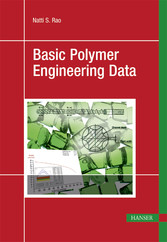Natti S. Rao
Basic Polymer Engineering Data
Preface
6
About the Author
8
Contents
10
1 Mechanical Properties of Solid Polymers
16
1.1 Ideal Solids
16
1.2 Tensile Properties
17
1.2.1 Stress-Strain Behavior
18
1.2.2 Tensile Modulus
20
1.2.3 Effect of Temperature on Tensile Strength
22
1.3 Shear Properties
22
1.3.1 Shear Modulus
23
1.3.2 Effect of Temperature on Shear Modulus
23
1.4 Compressive Properties
25
1.4.1 Bulk Modulus
26
1.5 Time Related Properties
27
1.5.1 Creep Modulus
27
1.5.2 Creep Rupture
29
1.5.3 Relaxation Modulus
29
1.5.4 Fatigue Limit
30
1.6 Hardness
33
1.7 Impact Strength
34
1.8 Coefficient of Friction
34
1.9 References
39
2 Thermal Properties of Solid and Molten Polymers
40
2.1 Specific Volume
40
2.2 Specific Heat
43
2.3 Thermal Expansion Coefficient
45
2.4 Enthalpy
46
2.5 Thermal Conductivity
47
2.6 Thermal Diffusivity
48
2.7 Coefficient of Heat Penetration
50
2.8 Heat Deflection Temperature
51
2.9 Vicat Softening Point
52
2.10 Flammability
53
2.11 References
56
3 Transport Properties of Molten Polymers
58
3.1 Newtonian and Non-Newtonian Fluids
58
3.2 Viscous Shear Flow
60
3.2.1 Apparent Shear Rate
60
3.2.2 Entrance Loss
61
3.2.3 True Shear Stress
62
3.2.4 Apparent Viscosity
63
3.2.5 True Shear Rate
65
3.2.6 True Viscosity
66
3.3 Rheological Models
66
3.3.1 Hyperbolic Function of Eyring and Prandtl
66
3.3.2 Power Law of Ostwald and de Waele
67
3.3.3 Polynomial of Münstedt
69
3.3.3.1 Shift Factor for Crystalline Polymers
70
3.3.3.2 Shift Factor for Amorphous Polymers
70
3.3.4 Viscosity Equation of Carreau
72
3.3.5 Viscosity Formula of Klein
75
3.4 Effect of Pressure on Viscosity
76
3.5 Dependence of Viscosity on Molecular Weight
77
3.6 Viscosity of Two-Component Mixtures
78
3.7 Melt Flow Index
78
3.8 Tensile Viscosity
80
3.9 Viscoelastic Properties
80
3.9.1 Primary Normal Stress Coefficient, Q
80
3.9.2 Shear Compliance, Je
81
3.9.3 Die Swell
82
3.10 Rheology of Glass Fiber-Filled Polypropylene Melts
82
3.10.1 Introduction
82
3.10.2 Model
83
3.10.3 Shift Factor as a Function of Fiber Content
85
3.10.4 Example
86
3.10.5 Summary
88
3.11 Practical Computational Rheology Primer
88
3.11.1 Introduction
88
3.11.2 Shear Flow
90
3.11.2.1 Relationship between Flow Rate and Pressure Drop
90
3.11.2.2 Shear Rates for Blown Film and Extrusion Coating Dies
93
3.11.2.3 Extensional Flow
95
3.11.2.4 Melt Elasticity
95
3.12 Conclusions
99
3.13 References
99
4 Electrical Properties
102
4.1 Surface Resistivity
102
4.2 Volume Resistivity
102
4.3 Dielectric Strength
103
4.4 Relative Permittivity
103
4.5 Dielectric Dissipation Factor or Loss Tangent
104
4.6 Comparative Tracking Index (CTI)
105
4.7 References
107
5 Optical Properties of Solid Polymers
108
5.1 Light Transmission
108
5.2 Haze
108
5.3 Refractive Index
109
5.4 Gloss
110
5.5 Color
110
5.6 References
111
6 External Influences
112
6.1 Physical Interactions
112
6.1.1 Solubility
112
6.1.2 Environmental Stress Cracking (ESC)
112
6.1.3 Permeability
114
6.1.4 Absorption and Desorption
115
6.1.5 Weathering Resistance
115
6.2 Chemical Resistance
116
6.2.1 Chemical and Wear Resistance to Polymers
117
6.3 General Property Data
118
6.4 References
125
7 Extrusion
126
7.1 Extrusion Screws
127
7.2 Processing Parameters
129
7.2.1 Resin-Dependent Parameters
129
7.2.1.1 Blown Film
130
7.2.1.2 Pipe Extrusion
131
7.2.1.3 Flat Film Extrusion
132
7.2.1.4 Sheet Extrusion
132
7.2.1.5 Wire Coating
133
7.2.2 Machine-Related Parameters
133
7.2.2.1 Extruder Output
133
7.2.2.1.1 Feed Zone
133
7.2.2.1.2 Metering Zone (Melt Zone)
135
7.2.2.2 Melting Parameter
142
7.2.2.3 Melting Profile
144
7.2.2.4 Screw Power
145
7.2.2.5 Melt Temperature and Melt Pressure
147
7.2.2.5.1 Melt Temperature
147
7.2.2.5.2 Temperature Fluctuation
148
7.2.2.5.3 Melt Pressure
149
7.2.2.5.4 Pressure Fluctuation
149
7.3 Extrusion Dies
160
7.3.1 Pipe Extrusion
162
7.3.1.1 General Cross Section
164
7.3.1.2 Drawdown and Haul-Off Rates
168
7.3.2 Blown Film
170
7.3.3 Sheet Extrusion
176
7.4 Thermoforming
178
7.5 Compounding
182
7.5.1 Coextrusion
183
7.6 Extrudate Cooling
185
7.6.1 Dimensionless Groups
188
7.7 References
190
8 Blow Molding
192
8.1 Processes
192
8.1.1 Resin-Dependent Parameters
194
8.1.1.1 Melt Temperature and Pressure
194
8.1.1.1.1 Processing Data for Stretch Blow Molding
195
8.1.1.1.2 Volume Shrinkage
195
8.1.1.1.3 Choice of Material
196
8.1.2 Machine-Related Parameters
196
8.1.2.1 Blow Molding Dies
196
8.2 References
198
9 Injection Molding
200
9.1 Resin-Dependent Parameters
203
9.1.1 Injection Pressure
203
9.1.2 Mold Shrinkage and Processing Temperature
203
9.1.3 Drying Temperatures and Times
206
9.1.4 Flow Characteristics of Injection-Molding Resins
206
9.2 Machine-Related Parameters
211
9.2.1 Injection Unit
211
9.2.2 Injection Molding Screw
212
9.2.2.1 Nonreturn Valves
213
9.2.2.1.1 Nozzle
214
9.2.3 Injection Mold
215
9.2.3.1 Runner Systems
215
9.2.3.2 Design of Gates
217
9.2.3.3 Injection Pressure and Clamp Force
219
9.2.4 Mechanical Design of Mold
227
9.3 Melting in Injection Molding Screws
229
9.3.1 Model
229
9.3.2 Calculation Procedure
231
9.3.3 Sample Calculation
231
9.3.4 Results of Simulation
232
9.3.5 Screw Dimensions
234
9.4 Injection Mold
235
9.4.1 Runner Systems
235
9.4.2 Calculated Example
235
9.4.3 Mold Filling
237
9.4.4 Injection Pressure
237
9.4.5 Calculated Example with Symbols and Units
238
9.5 Flow Characteristics of Injection Molding Resins
240
9.5.1 Model
241
9.5.2 Melt Viscosity and Power Law Exponent
242
9.5.3 Experimental Results and Discussion
243
9.5.4 Sample Calculation
245
9.6 Cooling of Melt in the Mold
246
9.6.1 Crystalline Polymers
246
9.6.2 Amorphous Polymers
248
9.6.3 Calculations with Varying Mold Wall Temperature
249
9.6.3.1 Sample Calculation with Symbols and Units
250
9.6.3.2 Iteration Procedure
251
9.6.3.3 Results of Calculations with the Model
251
9.7 Rheological Design of the Mold
255
9.7.1 Sample Calculation
255
9.7.2 General Channel Shape
258
9.8 References
258
9.9 Appendix
260
Index
262
© 2009-2024 ciando GmbH
 Zu Hanser-Fachbuch.de
Zu Hanser-Fachbuch.de
 Warenkorb
Warenkorb
